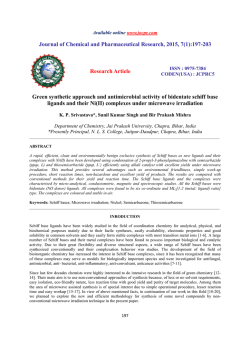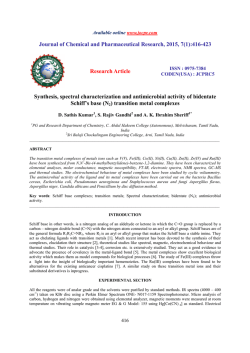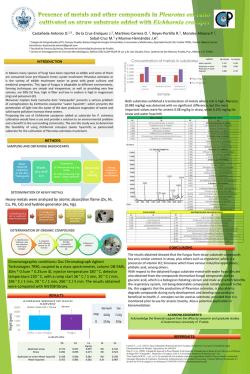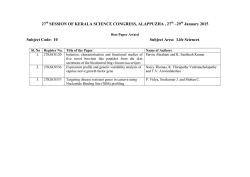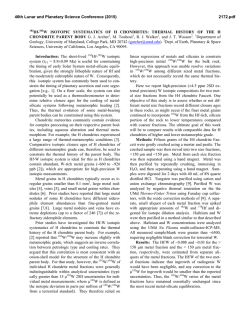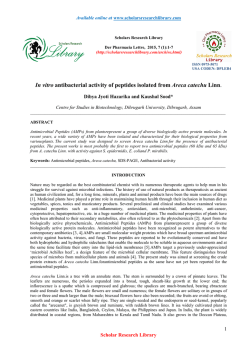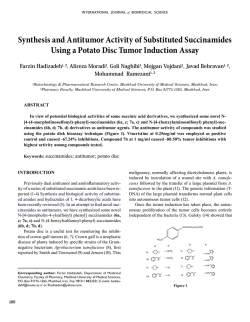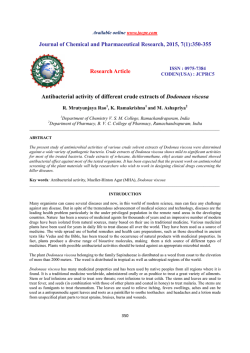
Synthesis, characterization and evaluation of some novel potential
Available online www.jocpr.com Journal of Chemical and Pharmaceutical Research, 2015, 7(1):541-545 Research Article ISSN : 0975-7384 CODEN(USA) : JCPRC5 Synthesis, characterization and evaluation of some novel potential HerboMineral complexes as antibacterial agents Abhishek Mishra1 and V. S. Velingkar2 1 Department of Pharmaceutical Chemistry, College of Pharmacy, 23, Jotejoy Building, R. S. Marg, Cuffe Parade, Mumbai 2 Shobhaben Pratapbhai Patel, School of Pharmacy & Technology Management, NMIMS University, V. L. Mehta Road, Vile Parle West, Mumbai _____________________________________________________________________________________________ ABSTRACT The application of inorganic chemistry to medicine is a rapidly developing field, and novel therapeutic and diagnostic metal complexes are now having an impact on medical practice [1], [2]. In this work, herbo-mineral complexes (of curcumin, Ferulic acid and Cinnamic acid) were synthesized with copper and zinc acetate salts. The method of synthesis was further optimized by altering one parameter at a time and keeping others constant. Purification of title compounds were performed by multiple washing with water and ethanol. The title compounds were characterized by UV, IR, Elemental analysis, inductively coupled plasma atomic emission spectroscopy (ICPAES), DSC and Karl Fischer analysis. Various physicochemical properties of title compounds were computed and compared with that of parent drug. To evaluate the changes in microbiological activity of parent drug after complexation, antibacterial studies were carried out and changes in MIC (minimum inhibitory concentration) of the complexes were compared with that of parent drug. It was thus observed that formation of complexes resulted in increase in antibacterial activity of parent drugs and MIC values were found to be decreased. Keywords: Herbo-mineral Complexes, Antibacterial activity, MIC. _____________________________________________________________________________________________ INTRODUCTION Metal complex is a structure consisting of a central atom or ion (metal) bonded with anions (ligands). Metal complexes are also known as coordination compounds, which include all metal compounds. [1], [2] The field of bioinorganic chemistry, which deals with the study of role of metal complexes in biological systems, has opened a new horizon for scientific research in coordination compounds. Some metals are essential for biological functions and are found in enzymes and cofactors required for various processes. For example, haemoglobin in red blood cells contains an iron porphyrin complex, which is used for oxygen transport and storage in the body. [2], [3] Metalorganics is the designation applied by common consent to those class ofcompounds, in which organic groups are linked to metal atom through heteroelement like oxygen, nitrogen, sulfur. The study of these types of compounds has contributed in manyways to the theory of chemical bonding. [3], [4], [5] 541 Abhishek Mishra and V. S. Velingkar J. Chem. Pharm. Res., 2015, 7(1):541-545 ______________________________________________________________________________ Microorganisms are very tiny one-celled organisms, viruses, fungi, and bacteria, and are found across the globe. An antibacterial is a compound or substance that kills or slows down the growth of bacteria.Ideally a useful antibacterial is the one, which has broader spectrum of activity with lesser untoward effects. It has been observed that significance of most conventional antimicrobial is slowly fading, since more and more microorganisms are acquiring resistance towards these agents. This condition may worsen in the near future. Hence there is an utmost need to synthesize newer antibacterial analogues with improved (broader) antimicrobial activity and lower resistivity of microorganisms. To overcome the problem of resistance shown by bacteria, it has been tried to prepare the complexes of antimicrobial herbal drugs with metal salt.so as to attain broad spectrum activity. [6], [7] Literature survey reveals that many herbal origin drugs possess antimicrobial activity.Curcumin, a yellow polyphenol pigment isolated from turmeric (Curcuma longa), commonly used as a spice in cooking, has utility in India not only as a dietary supplement but also for healthcare. It exhibits antioxidant, anti-inflammatory, antimicrobial, and immunomodulatory activities. Ferulic acid is a hydroxycinnamic acid, a type of organic compound. It is an abundant phenolic phytochemical found in plant cell wall components such as arabinoxylans as covalent side chains. Cinnamic acid is an organic compound with the formula C6H5CHCHCO2H. It is a white crystalline compound that is slightly soluble in water. Classified as an unsaturated carboxylic acid, it occurs naturally in a number of plants. It is obtained from oil of Cinnamon, or from Balsams such as storax. It possess antimicrobial and antioxidant properties.Literature survey also reveals that copper and zinc metal also possess antimicrobial properties. Many complexes of synthetic as well as natural drugs with copper and zinc metal have been prepared and tested for antimicrobial activity. [8], [9], [10], [11] The above literature survey gave an innovative idea of investigating the coordination chemistry of some herbal drugs with metal ion. Thus with this dual idea of utilizing the benefits of copper and zinc and broadening of antibacterial activity of herbal drugs, attempts were made to synthesize coordination complexes of herbal drugs with copper and zinc. EXPERIMENTAL SECTION Materials: Selected herbal drugs i.e. Curcumin, Ferulic acid and Cinnamic acid were procured from Sigma Aldrich Corporation Ltd. Copper acetate and Zin acetate were also obtained from Sigma Aldrich Corporation. Synthesis: The title compounds were synthesised by following scheme: Preparation of drug-metal complex. The selected drugs (1 mmol) and metal salts (1 mmol) were dissolved in ethanol separately and mixed together. The reaction mixtures were stirred at room temperature with simultaneous adjustment of basic pH using ammonia solution. After attaining desired pH, mixtures were refluxed at 600 C for 3 hours with simultaneous checking and adjusting pH to alkaline. They were then allowed to stand overnight. The precipitated complexes were filtered off, washed with ethanol, ammonia solution and water and finally dried in oven at 600C. Metal salts used were Copper acetate and Zinc acetate separately for synthesis of drug-metal complex. [12], [13] Characterization of Herbo-Mineral complexes: Infra-red spectra of title compounds were recorded in the range of 4000-400 cm-1 with Schimadzu FT IR8300, using KBR pellet method. Ultraviolet (Uv) spectra were efficiently recorded on Schimadzu 1700. Elemental analysis was performed using thermofinnagane-EA112 series NCHS Analyser. Metal content was determined using Thermo S- series atomic absorption spectrometer. Karl fisher titrimeter (Vegomatic) was used for the determination of water content. DSC analysis was performed using Mettler Toledo 821e, DSC (Mettler Toledo, Switzerland). The sample size used for DSC was about 5 mg. The scanning speed was kept at 10 C/min. 542 Abhishek Mishra and V. S. Velingkar J. Chem. Pharm. Res., 2015, 7(1):541-545 ______________________________________________________________________________ 1) Degradation Point and Percentage Yield of Title Compounds: Table: 1 SR.NO TITLE COMPOUNDS 1 2 3 4 5 6 Curcumin-Copper complex Curcumin-Zinc Complex Ferulic acid-Copper Complex Ferulic acid-Zinc Complex Cinnamic acid-Copper Complex Cinnamic acid-Zinc Complex MELTING POINTS (DECOMPOSITION) Onset of Decomposition. 233.10 242.34 198.28 312.98 290.68 284.33 PERCENTAGE YIELDS % 73.45 70.65 73.23 69.70 70.25 68.70 2) UV Spectral analysis: Ultraviolet (UV) spectra were efficiently recorded on JASCO V-550 UV/Vis spectrophotometer. Table: 2 SR.NO 1 2 3 4 5 6 TITLE COMPOUNDS Curcumin-Copper complex Curcumin-Zinc Complex Ferulic acid-Copper Complex Ferulic acid-Zinc Complex Cinnamic acid-Copper Complex Cinnamic acid-Zinc Complex λmax (nm) 432 470 343 346 268 270 SOLVENTS USED 0.1N NaOH 3) ELEMENTAL ANALYSIS: Elemental analysis was carried out using Thermofinnagane-EA112 series NCHS Analyser. Theoretically calculated and practically observed percentage of Carbon, Hydrogen in title compounds are as follow: Table: 3 COMPOUNDS Empirical formula TC %C PO TC %H PO Curcumincopper complex C23H22O8C. H2O 54.38 55.42 4.73 4.52 Curcumin-Zinc complex C23H22O8Zn. H2O 54.18 54.87 4.71 4.47 Ferulic acidcopper complex C12H12`O6Cu. H2O 43.18 42.53 4.20 4.13 Ferulic acidZinc complex C12H12`O6Zn. H2O 42.93 42.67 4.17 3.96 Cinnamic acidcopper complex C11H10O4Cu. H2O 45.91 45.29 4.17 3.87 Cinnamic acidzinc complex C11H10O4Zn. H2O 45.61 45.03 4.15 4.01 4) INDUCTIVELY COUPLED PLASMA ATOMIC EMISSION SPECTROSCOPY(ICP-AES): Table: 4 SR.NO Code of Samples Given Name of Compound Concentration of Metal (ppm) 1 2 3 4 5 6 A B C D E F Curcumin-Copper complex Curcumin-Zinc Complex Ferulic acid-Copper Complex Ferulic acid-Zinc Complex Cinnamic acid-Copper Complex Cinnamic acid-Zinc Complex 131.888 136.111 216.802 223.557 241.167 254.777 % of Metal Theoretically Practically Observed Calculated 12.55 13.18 12.84 13.61 19.04 21.68 19.5 22.35 22.09 24.17 22.6 25.48 5) Karl –Fisher Titrimetry for Water Content: Karl – Fisher titration was performed in order to find out the number of bonded water molecules. Karl – Fisher reagent was calibrated with disodium tartrate. An accurately weighed amount of compound was added to the dry methanol in KF reaction vessel and titrated against Karl – Fisher reagents. Titration was performed in triplicate to get reproducible results. 543 Abhishek Mishra and V. S. Velingkar J. Chem. Pharm. Res., 2015, 7(1):541-545 ______________________________________________________________________________ EVALUATION OF ANTIBACTERIAL ACTIVITY: The minimum inhibitory concentrations (MIC) of parent herbal drugs as well as synthesized complexes were determined by agar diffusion method using Brain Heart Infusion agar for antibacterial and sabouraud agar medium was used for antifungal studies as described by the National Committee for Clinical Laboratory Standards in its guidelines (NCCL Guidelines, 1993; United States Pharmacopoeia, 2002). Samples were initially dissolved in 0.1 N NaOH at concentration-75µl, 50µl,25 µl,10 µl. Isolates were grown for 24 h in nutrient broth to provide a turbidity of approximately 109 cfu/ml. Bacterial suspensions were diluted with soft agar containing tubes at 45–50 ◦C. These soft agar tubes were then poured over the Muller Hinton agar plates previously prepared and allowed to solidify under laminar flow for 15 min. Filter paper discs, previously sterilized were, placed over the agar plates containing bacterial suspensions. Sterile pipettes (0.2 ml) were used in aseptic conditions to add the compounds on filter paper disc. Sample solution (0.15 ml) was added to each disc. Same volume of the control (DMSO) was also added on one of the other disc in each plate. The plates were then placed in an incubator at 37 ◦C within 15 min of addition of the compounds on the filter paper disc. After 18–24 h of incubation, the plates were examined and the diameter of zones of complete inhibition was measured by zone diameter measuring scale. RESULTS AND DISCUSSION UV spectral analysis of all synthesised complexes showed a hypsochromic shift as compared to parent drug which indicated that an auxochrome is no longer free to give absorbance at specified wavelength. IR spectral data showed prominent absorption peaks for peculiar functional groups at the expected frequencies for all title compounds. IR spectrum of Ferulic acid and Cinnamic acid complexes with copper and zinc has not shown any peak in range of 1690-1710cm-1 indicating disappearance of carboxyl group of parent drug due to deprotonation of COOH group whereas IR spectra of Curcumin-copper complex and Curcumin-zinc complex showed broad peak at 3500 cm-1 indicating, there is shift in peak of hydroxyl group, which also suggested that hydroxyl groups are involved in complex formation. Karl Fischer analysis for synthesised complexes showed smaller percentage of water which indicated the fact of presence of coordinated water molecule with active molecule. Inductively coupled plasma emission spectroscopy was carried out to determine the percentage of metal in synthesised complexes. Differential scanning calorimetry, (DSC) was carried out to ascertain the purity of title compounds and nature of compounds. DSC spectra of all synthesised complexes showed crystalline nature with degradation behaviour and also showed absence of parent drug peak. Spectra also indicated absence of melting point peak for all synthesised complexes. CONCLUSION Thus, it can be concluded that such complexes can be utilized as antibacterial agents. It therefore makes a scope for future detailed studies of microbiological screening, toxicology as well as formulation and development of most prominent compounds. Also, similar such compounds can be prepared and studied so as to improve their antimicrobial spectra. Acknowledgements The authors are thankful to SAIF, IIT Mumbai India for providing atomic absorption spectroscopy facility. REFERENCES [1] Macomber R, Organic Chemistry, Vol.II, Viva Books Pvt Ltd Publications 41-42(1998). [2] Peter J. Sadler and ZijianGuo, Pure & Appl. Chem.70, 1998, 863-871. [3] Houghton R.P., Metal Complexes in Organic Chemistry, Cambridge University Press, 1979, 1-3 and 73-75. [4] Powell P. Principles of organometallic chemistry, 2nd edition Chapman and Hall Publication New York, 1988, 28. [5] Pauling l., The Nature of the Chemical Bond, 3rd edition, Comell University Press Ithaca, 1966, 88. 544 Abhishek Mishra and V. S. Velingkar J. Chem. Pharm. Res., 2015, 7(1):541-545 ______________________________________________________________________________ [6] Pelczar M. J. Jr., Chan E. C. S, Krieg N. R. “Microbiology”, 5th edition, Tata McGraw- Hill edition, New Delhi, 1933, 74-77. [7] Baker F.J. Handbook of Bacteriological techniques 2nd edition Butterworths, 1967, 187-190. [8] Marjorie Murphy Cowan “Plant products as antimicrobial agents” Clinical Microbiology Reviews Vol-12, 1999, 564-582. [9] W.C.Evans. “Trease and Evans Pharmacognosy” 15th edition, W.B.Saunders, Newyork, 2002, 178-246. [10] C.K.Kokate, A.P.Purohit, S.B.Gokhale”Pharmacognosy” Niraliprakashan, 42nd edition, 2008, 83-96. [11] IonelaDacianaCiocan, Ion I. Băra, “Plant Products As Antimicrobial Agents”, TOM VIII, AnaleleŞtiinţifice ale Universităţii „AlexandruIoanCuza”, SecţiuneaGeneticăşiBiologieMoleculară, , 2007. [12] Bambani, Shetty J., Laxmidevi, College Inorganic Chemistry, 2nd edition, Himalaya publishing House, 1980, 217-219. [13] Carrmalt C. J. Walsh D. Cowley A. H., Norman N.C., Organometallics, 1997, 16,359. 545
© Copyright 2024
